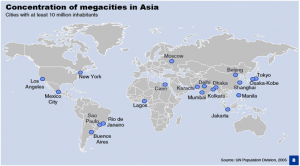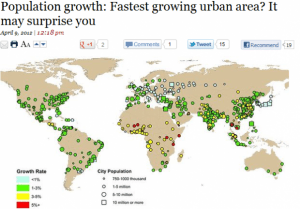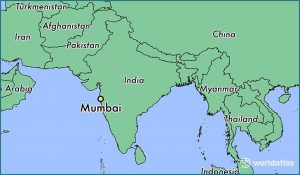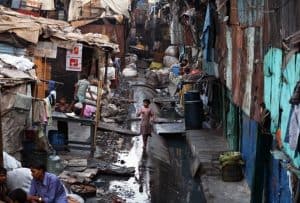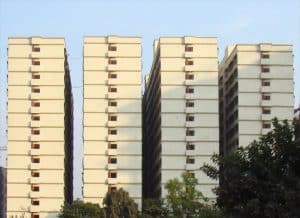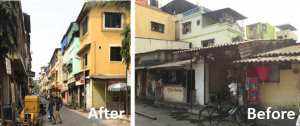Urbanisation is a process affecting the world. 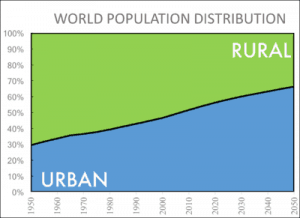 The majority of the world’s population now live in urban areas.
The majority of the world’s population now live in urban areas.
Today there are 20 megacities. By 2025 there could be 37.
The rate of urban growth is fastest in LICs. This graph shows  urban populations growing rapidly in low and middle income countries. The urban areas in high income countries are only growing slowly.
urban populations growing rapidly in low and middle income countries. The urban areas in high income countries are only growing slowly.
Urban areas are growing fastest in Africa and Asia. Urban areas are growing more slowly in Europe.
CASE STUDY
Mumbai – rapidly growing city in a Low Income Country (LIC) or Newly Emerging Economy (NEE)
Mumbai is a megacity in India. It was formerly called Bombay. It is located on the west coast, next to the Indian Ocean. Mumbai grew due to trade. It used to export spices from Maharashtra state. Today it is a major industrial and financial centre, exporting cars, chemicals and textiles.
Mumbai has a GDP (Gross Domestic Product) of US$ 368 billion and the city accounts for 6% of India’s total GDP. Its main industries are Bollywood films, finance and banking, textiles and clothing, IT. Its main employers are Tata (steel, cars, trucks, chemicals, food), Alliance Industries (oil, energy, chemicals).
| Importance of Mumbai and Birmingham | ||
| Mumbai, India | Birmingham, UK | |
| Population | 18.4 million | 1.1 million |
| Population world ranking | 5 | 365 |
| City size | Largest city in India | Second largest in UK |
| Total GDP (Gross Domestic Product) | US$ 368 billion | US$ 114 billion |
| GDP per person | US$ 7000 | US$ 30 000 |
| Main industries | Bollywood films, finance and banking, textiles and clothing, IT. | Cars, engineering, jewellery, retail, insurance, law |
| Major employers | Tata (steel, cars, trucks, chemicals, food), Alliance Industries (oil, energy, chemicals) | Jaguar (cars), Rolls Royce (aerospace, industrial, marine), Cadburys (chocolate) |
Mumbai is the largest city in India with a population of 18.4 million people. It is rapidly growing: 600 000 people are added to the population each year. Its rapid growth is due to urbanisation: the movement of people from rural areas to cities. The push factors from the countryside include lack of jobs, low wages and limted access to services such as healthcare and education. The pull factors for the city include the ease of finding work in the informal sector, higher pay, educatioand the possibility of making a better life. Mumbai also has a high rate of natural increase. This is because Mumbai’s population is relatively young and, therefore, more likely to start a family. There is a youthful population because most migrants moving to a city tend to be in their twenties.
Opportunities
The economic opportunities of living in Mumbai include higher pay. For example, In Mumbai, the pay for a typical maid would be 10 000 rupees a month (£120). In rural areas, the majority earn less than 5000 rupees a month (£60). In urban areas, there is better access to healthcare. Consequently, life expectancy is 21 years longer in Mumbai than in the countryside. There is also improved access to education (where literacy rates are 85% compared to 69%, transport (2 billion make journeys by train), electricity (20% of rural Indian lack electricity) and telecommunications (88% have access to mobile phones compared 68%).
Challenges
Dharavi is India’s largest slum (squatter settlement), where 1 million people live in each square mile (400 000 per km2). Dharavi is overcrowded, there is on average 6 people per room. 12 neighbours share a tap and water rationed to between 5.30am and 7.30am each morning. Sanitation is poor as 500 people share a toilet, many defecate in the open and most sewers are open drains. Consequently, there are 4000 cases of water borne disease a day.
In Dharavi 85% of people have a job and unemployment is low. 80% of Mumbai’s waste is recycled in Dharavi. For example, there 35 000 rag pickers. Many products are made the 15 000 one room factories and workshops in the slum, such as potteries, bakeries, clothing, leather goods and manufactured components. The output from Dharavi’s businesses is US$ 1 billion per year. However, working conditions can be poor with hazardous chemicals used and long hours and pay in this informal sector can be low – £1 per day.
Elsewhere in Mumbai, traffic congestion is a problem. There has been a 57% increase in cars 23% increase in buses. Nitrous oxide emissions are 3 times their safe limit. Air pollution leads to 80 000 deaths per year. Rapid growth also creates problems for education. For example, 65% of primary schools have more than 35 pupils per class. Hospitals are under pressure due to the rising population and poor sanitation: Dharavi’s hospital admits 3000 patients a day. Crime is not a serious problem in Mumbai. For example, racist incidents are low. However, bribery and corruption of officials is local people’s main crime concern.
Urban planning
Mumbai’s ‘Slum Rehabilitation Authority’ is trying to improve the quality of life for slum dwellers with clearance and redevelopment. If 70% of an area’s residents agree, then they will all be relocated to other parts of the city and given a home in a new 14 storey tower blocks. People will only be eligible for the new 27m2 flat if they can prove that they have lived in the slum since 2000.
| Advantages | Disadvantages |
| Slum dwellers get a new, purpose built home. | Communities broken up and scattered across Mumbai |
| New homes have running water, electricity and sanitation | New homes are much smaller than the old ones in the slums. |
| Old slum land can be redeveloped creating jobs. | New tower blocks have no places for industry or workshops |
An alternative approach is illustrated by ‘National Slum Dwellers’ Association’. This incremental approach installs underground sewers and paved roads. Small loans have been granted to slum residents to improve their homes. Small single-story homes are now houses with 2-3 levels. Families have added bathrooms and kitchens and replaced tin roofs with tiles. In Mumbai 35 000 people now live in improved homes and 300 toilet blocks have been built.
| Advantages | Disadvantages |
| Communities, friends and neighbours remain together | Improvements can take a long time to achieve |
| Industry and workshops remain close to where people live | Little chance to plan for transport and add roads |
| Slums improved a lower cost than redevelopment | Home built structures vulnerable to storm damage or earthquakes |
